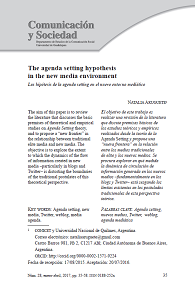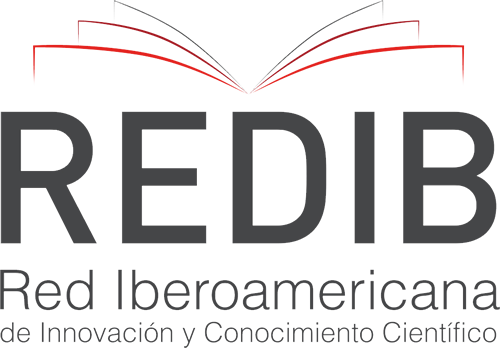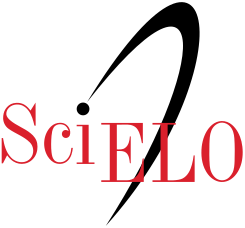The agenda setting hypothesis in the new media environment
DOI:
https://doi.org/10.32870/cys.v0i28.2929Palabras clave:
Agenda setting, nuevos medios, Twitter, weblog, agenda mediáticaResumen
El objetivo de este trabajo es realizar una revisión de la literatura que discute premisas básicas de los estudios teóricos y empíricos realizados desde la teoría de la Agenda Setting y propone una “nueva frontera” en la relación entre los medios tradicionales de elite y los nuevos medios. Se procura explorar en qué medida la dinámica de circulación de información generada en los nuevos medios –fundamentalmente en los blogs y Twitter– está sesgando los límites existentes en los postulados tradicionales de esta perspectiva teórica.Descargas
Citas
Adamic, L. & Glance, N. (2005). The political blogosphere and the 2004 U.S. election. Proceedings of the 3rd international workshop on Link discovery, 36-43. doi: 10.1145/1134271.1134277
Artwick, C. (2012). Body found on Twitter : The role of alternative sources in social media agenda setting. International Communication Association Conference (pp. 1-29). Phoenix: International Communication Association.
Aruguete, N. (2016). Es difícil sostener la idea de la democratización de Twitter. Diario Página 12. Retreive March, 17th, 2016 from http:// www.pagina12.com.ar/diario/dialogos/21-293456-2016-02-29.html
Aruguete, N. (2015). El poder de la agenda. Política, medios y público. Buenos Aires: Biblos.
Aruguete, N. (2013). La narración del espectáculo político: pensar la relación entre sistema de medios y poder político. Austral Comunicación, 2 (2), 205-216.
Bachmann, I. & Harlow, S. (2012). Interactivity and Multimedia in Latin American Newspapers: Inroads in an Incomplete Transition. Cuadernos de Informacion, 30, 41-52.
Baum, M. A. & Groeling, T. (2008). New Media and the Polarization of American Political Discourse. Political Communication, 25 (4), 345-365.
Bennett, W. L. (1990). Toward a Theory of Press-State Relations in the United States. Journal of Communication, 40 (2), 103-127.
Bennett, W. L. (2012). News: The Politics of Illusion. New York: Longman Pearson.
Berger, L. & Freeman, M. (2011). The Issue of Relevance of Agenda- Setting Theory to the Online Community. Meta-Communicate, 1 (1), 1-22.
Boczkowski, P. (2010). News at Work. Imitation in an Age of Information Abundance. Londres: The University of Chicago Press.
Bruns, A. (2008). Blogs, Wikipedia, Second Life and beyond: From production to produsage. New York: Peter Lang.
Calvo, E. (2015). Anatomía política de Twitter en Argentina. Buenos Aires: Capital Intelectual.
Castells, M. (2009). Comunicación y Poder. Barcelona: Alianza.
Charron, J. (1998). Los medios y las fuentes. Los límites al modelo del agenda setting. In G. Gauthier, A. Gosselin & J. Mouchon (Eds.), Comunicación y política (pp. 72-93). Barcelona: Gedisa.
Coleman, B. R. & McCombs, M. (2007). The Young and Agenda-less? Exploring Age-related Differences in Agenda Setting on the Youngest Generation, Baby Boomers, and the Civic Generation. Journalism and Mass Communication Quaterly, 84 (3), 495-508.
Coleman, R., McCombs, M., Shaw, D. & Weaver, D. (2009). Agenda Setting. In K. Wahl-Jorgensen & T. Hanitzsch (Eds.), The Handbook of Journalism Studies (pp. 147-160). New York: Routledge.
Cornfield, M., Carson, J., Kalis, A. & Simon, E. (2005). Buzz, Blogs and Beyond: the Internet and the National Discourse in the Fall of 2004. Pew Internet and American Life Project, 23, 1-33.
Farhi, P. (2009). The Twitter explosion. American Journalism Review. Retreive August, 17th, 2016 from http://ajrarchive.org/Article. asp?id=4756
Ferree, M. M., Gamson, W. A., Gerhards, J. & Rucht, D. (2002). Shaping Abortion Discourse. Democracy and the Public Sphere in Germany and the United States. Cambridge: Cambridge University Press.
Gane, N. & Beer, D. (2008). New media. New York: Berg.
Haas, T. (2005). From “public journalism” to the “public’s journalism”? Rhetoric and reality in the discourse on weblogs. Journalism Studies, 6, 387-396.
Howe, J. (2006). The rise of crowdsourcing. Wired Magazine, 14 (6), 1-4.
Kiousis, S. (2002). Interactivity: A Concept Explication. New Media & Society, 4 (3), 355-383.
Kushin, M. J. (2010). Tweeting the Issues in the Age of Social Media? Intermedia Agenda Setting between The New York Times and Twitter. Doctoral dissertation, Washington State University, Washington, United States.
Lasorsa, D. L., Lewis, S. C. & Holton, A. E. (2012). Normalizing Twitter: Journalism Practice in an Emerging Space. Journalism Studies, 13 (1), 19-36.
Lazarsfeld, P. F., Berelson, B. & Gaudet, H. (1948). The People’s Choice: How the Voter Makes Up his Mind in a Presidential Campaign. New York: Columbia University Press.
Lecaros, M. J. & Greene, F. (2012). Editores Chilenos y Rutinas Periodísticas: Revisión y Propuesta para un estudio sobre el cambio en la sala de redacción. Cuadernos de Informacion, 30, 53-60.
Lee, B., Lancendorfer, K. M. & Lee, K. J. (2005). Agenda-Setting and the Internet: The Intermedia Influence of Internet Bulletin Boards on Newspaper Coverage of the 2000 General Election in South Korea. Asian Journal of Communication, 15 (1), 57-72.
Lee, G. (2005). Agenda Setting Effects in the Digital Age: uses and effects of online media. Doctoral dissertation, University of Texas, Austin, United States.
Manovich, L. (2001). The Language of New Media. Cambridge: MIT Press.
McCombs, M. E. (1993). La comunicación de masas en las campañas políticas: información, gratificación y persuasión. In M. de Moragas (Ed.), Sociología de la Comunicación de Masas (pp. 95-121). Barcelona: Gustavo Gili.
McCombs, M. E. (2005). A look at agenda setting: Past, present and future. Journalism Studies, 6 (4), 543-557.
McCombs, M. E., & Shaw, D. (1972). The Agenda-Setting Function of the Mass Media. Public Opinion Quarterly, 36, 176-187.
McCombs, M. E. & Weaver, D. H. (1973). Voters’ need for orientation and use of mass communication. Paper presented at the Annual Conference of the International Communication Association, Mon-treal, Canada.
McMillan, S. J. (2000). Interactivity is in the Eye of the Beholder. Function, Perception, Involvement, and Attitude Toward Web Sites. In M. A. Shaver (Ed.), Proceedings of the 2000 Conference of the American Academy of Advertising (pp. 71-78). East Lansing: Michigan State University.
Meraz, S. (2009). Is There an Elite Hold? Traditional Media to Social Media Agenda Setting Influence in Blog Networks. Journal of Computer-Mediated Communication, 14 (3), 682-707.
Meraz, S. (2011). Using Time Series Analysis to Measure Intermedia Agenda-Setting Influence in Traditional Media and Political Blog Networks. Journalism & Mass Communication Quarterly, 88 (1), 176-194.
Messner, M. & Distaso, M. W. (2008). The Source Cycle. How traditional media and Weblogs use each other as sources. Journalism Studies, 9 (3), 447-463.
Murley, B. & Smith, K. (2005). Bloggers Strike a Nerve: Examining the Intersection of Blogging and Journalism. Paper presented in the Media Ethics Division at the AEJMC Convention, San Antonio, Texas. United States.
Oblak, T. (2005). The lack of interactivity and hypertextuality in online media. Gazette, 67 (1), 87-106.
O’Connor, R. (2009). Facebook and Twitter Are Reshaping Journalism As We Know It. AlterNet, 20. Retreive January, 10th, 2016 from http://www.alternet.org/story/121211/facebook_and_twitter_are_ reshaping_journalism_as_we_know_it
O’Donnell, G. (2007). Disonancias. Buenos Aires: Prometeo.
Parmelee, J. H. (2014). The agenda-building function of political tweets. New Media & Society, 16 (3), 434-450.
Parmelee, J. & Bichard, S. (2012). Politics and the Twitter Revolution: How Tweets Influence the Relationship between Political Leaders and the Public. Lanham: Lexington Books.
Reese, S. & Danielian, L. (1989). Intermedia influence and the drug issue: Converging on cocaine. Communication Campaigns about Drugs: Government, media, and the public, 5, 29-46.
Reese, S. D., Rutigliano, L., Hyun, K. & Jeong, J. (2007). Mapping the blogosphere: Professional and citizen-based media in the global news arena. Journalism, 8 (3), 235-261.
Roberts, M. S., Wanta, W. & Dzwo, T. H. (2002). Agenda Setting and Issue Salience Online. Communication Research, 29 (4), 452-465.
Rubio García, R. (2014). Twitter y la teoría de la Agenda-Setting: mensajes de la opinión pública digital. Estudios sobre el Mensaje Periodístico, 20, 249-264.
Salwen, M., Garrison, B. & Driscoll, P. (2005). Online News and the Public. Mahwah: Lawrence Erlbaum.
Schultz, T. (2000). Mass media and the concept of interactivity: an exploratory study of online forums and reader email. Media Culture Society, 22 (2), 205-221.
Schultz, B. & Sheffer, M. L. (2010). An exploratory study of how Twitter is affecting sports journalism. International Journal of Sport Communication, 3, 226-239.
Shaw, D. & McCombs, M. E. (Eds.). (1977). The Emergence of American Political Issues: The Agenda-setting Function of the Press. Saint Paul: West.
Shaw, D., Hamm, B. J. & Knott, D. L. (2000). Technological Change, Agenda Challenge and Social Melding: mass media studies and the four ages of place, class, mass and space. Journalism Studies, 1 (1), 57-79.
Singer, J. B. (2005). The political j-blogger Normalizing a new media form to fit old norms and practices. Journalism: Theory, Practice, and Criticism, 6 (2), 173-198.
Thorndyke, J. (20012). The Role of Agenda Setting in Social Media: A Look at the Relationship Between Twitter and the Mass Media’s Agenda. Vasa. Carolina del Norte, USA.
Wallsten, K. (2010). “Yes We Can”: How Online Viewership, Blog Discussion, Campaign Statements, and Mainstream Media Coverage Produced a Viral Video Phenomenon. Journal of Information Tech-nology & Politics, 7 (2-3), 163-181.
White, D. (1950). The “Gate-Keeper”: A case study in the selection of news. Journalism Quarterly, 34, 383-390.
Winter, J. P. & Eyal, C. (1981). Agenda-Setting for the Civil Rights Issue. Public Opinion Quarterly, 45 (3), 376-83.
Yu, J. & Aikat, D. (2006). News on the Web: Agenda Setting of Online News in the Websites of Major Newspaper, Television Bruns, and Online News Services. In Annual Meeting of the International Communication Association, Nueva York, 1-15.
Zucker, H. G. (1978). The Variable Nature of News Media Influence. In B. D. Rubin (Ed.), Communication Yearbook 2 (pp. 225-245). New Brunswick: Transaction Publishers.

Descargas
Publicado
Cómo citar
Número
Sección
Licencia
Los autores/as que publiquen en esta revista aceptan las siguientes condiciones:
De acuerdo con la legislación de derechos de autor, los autores conservan los derechos de autoría y otorgan a Comunicación y Sociedad el derecho de primera comunicación pública de la obra. Comunicación y Sociedad no realiza cargos a los autores por enviar y procesar artículos para su publicación.
Los autores/as pueden realizar otros acuerdos contractuales independientes y adicionales para la distribución no exclusiva de la versión del artículo publicado en Comunicación y Sociedad (por ejemplo incluirlo en un repositorio institucional o publicarlo en un libro) siempre que indiquen claramente que el trabajo se publicó por primera vez en Comunicación y Sociedad.










